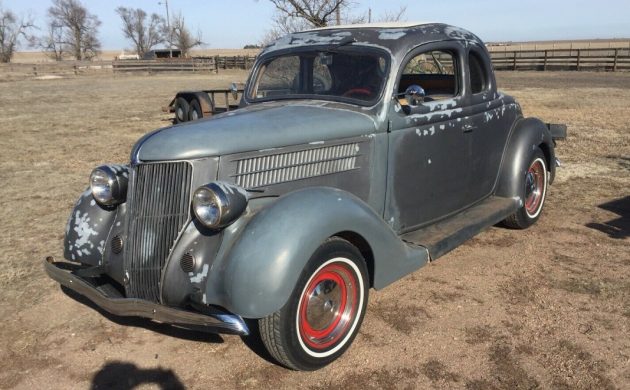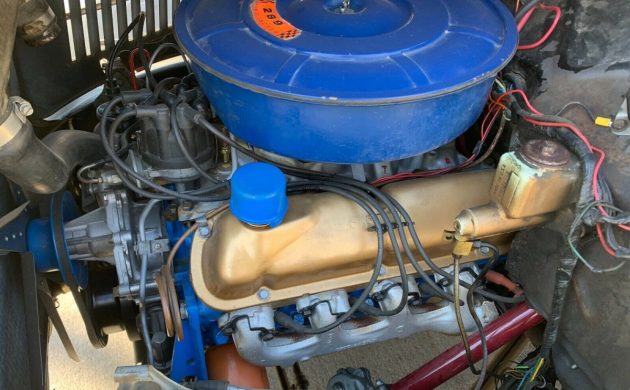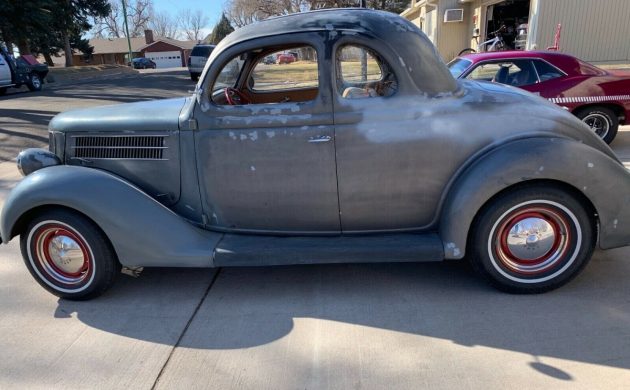This 1936 Ford Coupe is an unfinished custom build. Its specifications aren’t radical, but it should still provide some noticeable performance improvements over a standard Coupe. It needs someone to finish the work, which appears to be mostly cosmetic. If you feel like tackling a great winter project, you will find the Ford located in Holyoke, Colorado, and listed for sale here on eBay. Bidding is sitting at $14,300, but the reserve hasn’t been met.
The person who ultimately tackles this project will be doing so from a sound base. The paint has seen better days, but the panels appear to be very straight. There are no significant dings or dents, and there is no visible external rust. The owner supplies some clear photos of the vehicle’s underside, and apart from the occasional light dusting of surface corrosion on the floors, it looks remarkably clean. The grille might require a trip to the platers, but the rest of the chrome and trim seems to be in good order. The same appears to be true of the glass, with no evidence of cracks or clouding.
The Ford’s engine bay would originally have housed a 221ci flathead V8, producing 85hp. That would have represented a respectable figure back in 1936, but time has marched on, and the car has received a significant performance boost. What we now find is what is claimed to be a 1965-vintage 289ci K-Code V8. This should be pumping out 271hp. The rest of the drivetrain remains original, which means that it features a 3-speed manual transmission. With more than triple the original power available under the right foot, the Coupe should get up and moving pretty well. The suspension is basically as it left the production line, while the owner doesn’t mention any upgrades to the braking system. That last point is one to ponder, and the buyer might want to look at this aspect of the car more closely. A front disc conversion might be a wise investment given the performance boost that Ford has received. Conversion kits can be found for around $600, and this could be money well spent. Otherwise, it would seem that the car is mechanically complete, and it is in good health. The owner says that everything works as it should.
It looks like someone has commenced the restoration of the Ford’s interior, which doesn’t leave a lot for the buyer to do. The door trims and seat cover appear to be reasonably new, but there is no headliner. Once again, this is an item that is not particularly expensive. An outlay of $250 will secure a high-quality headliner, and installing this would not be hard. The paint on the dash looks presentable, but whether it remains Silver will depend on what color the buyer chooses to refinish the exterior. There are a few additional gauges fitted to the dash to monitor the health of the V8, and I would probably consider replacing these so that they all match. Beyond that, there isn’t a lot of work required here.
I like this 1936 Ford, and I believe that there is plenty of potential waiting to be unleashed by the right person. It seems that I’m not alone in this opinion. The auction initially opened at $500, but it has quickly rocketed to the current level off the back of some intense bidding. Finishing the project would seem to be a straightforward proposition, and this is one car that I would like to get a look at once the work is complete.







If it has original brakes, they would be mechanical rod operated brakes which were substandard when new. GM and Chrysler both had hydraulic brakes for years before Ford adopted them in 1939. Looks like a good project for someone. It may be approaching an unrealistic price soon. Restoration costs are increasing and the 30’s cars are not. Still 1936 is my favorite Ford.
There’s a master cylinder on the firewall.
Nice little ‘36 5 window. However that small block Ford is not a K Code High Performance 289. The harmonic balancer? Standard small block. The distributor? Standard vacuum advance. Exhaust manifolds? Standard. From the inception of the K Code High Performance 289 in mid 1963 the false claims of a 289, or 260/302, being a Hi-Po have been common. Do a search on what makes a genuine High Performance 289. A 4bbl. Carb and a “hot” cam combo do not make a Hi-Po.
But this coupe has a lot of potential.
Looks like something that could have been built in 1970. Way back in the twilight zone now. Y2K or just drive it.
the original drive line wouldn’t last long with a heavy right foot!
Master cyl is for the clutch I believe.
Gary M,
In the photo of the interior, you can see the swing pedal assembly for the brake pedal, and it appears the clutch pedal still heads for the floor when pressed. As it’s still got the original top loader 3-speed, I’m bettin’ it’s got the original mechanical clutch linkage.
Any one who buys this rust free car with an updated motor, might want to consider going back to a later flathead Ford motor, and build it from there, as the engine shown does not appear to be a K code. This would make a great 1950’s tribute street rod.
But there are 2 things I see that should get fixed quickly;
1. Replace that back sparkplug wire with a 90 degree plug wire terminal end, so it’s not rubbing on both the firewall and the steering column.
2. The car still has the original radiator, with one of the top hose connections plugged. This means the entire cooling system flow is thru one very small opening at the top of the radiator. These cars had cooling flow problems when they were using both hoses, now it’s down to just one. And don’t forget the bottom hoses were a pair as well, with probably one of those blocked off too. I suspect that at higher driving speeds, it might run a bit hot.
But these are easy changes, and don’t really detract much from what is offered; a nice, rust free and accident free 3 window coupe, with lots of potential. Chances are, whoever buys it for top dollar will understand the intrinsic value of a rust free coupe body.
Minor point top shifter not top loader top loader trans was the later Ford trans which was a side shifter sorry for the nitpicking but just saying
Camaro guy,
Thanks for reminding me, I shoulda known better, just didn’t take the time to proof read this time!
Even if it is the master cylinder for the brakes it needs to be up dated to a dual cylinder for safety sake.
Common misconception. Doesn’t matter if you have a single or dual brake master cylinder, if a line anywhere with a dual master fails the pedal goes to the floor and you have no brakes. Don’t believe it? Crack open a bleeder screw on your modern car, go for a drive and see if you have ANY brake pedal. Ever bleed brakes? Why does the pedal go to the floor if you are only bleeding one caliper? I wish people would just stop it with these old wives tales.
Dave,
I must correct your statement. Cracking a bleed screw will cause you to lose that circuit of the brake system, but if it’s correctly set up, the other circuit will still be working. A dual master cylinder is basically a pair of pistons aligned in the same cylinder. Once the fluid is displaced by the failed section, the other section will pressurize as long as the pedal is pressed down.
A nice simple diagram can be seen here:
https://www.angelfire.com/hiphop3/ppddaiddddyy/Brakeseng.html
A couple of years ago I had the main rear brake line to the rear axle blow on my 2001 Ram 2500 utility truck, it rusted out from the inside. It took a hard stomp on the pedal in a panic situation to rupture the line. I was driving in the left lane of I-95 in Virginia, heavy traffic congestion, at about 65mph. And did I mention I had a full load in the bed?
Pedal suddenly went down about 3/4 of the way until the other half of the master cylinder’s piston built up pressure just like it should.
No accident, just a lot of adrenaline! Continued driving the 100+ miles home, as it was late on a Sunday evening. But I did take it easy & kept speeds down. And yep, I replaced ALL the brake lines on the truck, finding several more that were weak.
One other nit pick: this is a Five Window Coupe. Not a Three window. Returning this ‘36 to Flathead power would be a wise move. Or …. go real ‘50s traditional by installing an Olds Rocket 303/324 backed by a Cad La Salle.
You could leave the 289, put a set of 60’s style mags with some redline tires and finally have that 1:1 version of the Hot Wheel you wanted 50 years ago ! – minus the rumble seat of course …
If you look at the under car photos you can see a brake hose going to the right front wheel.